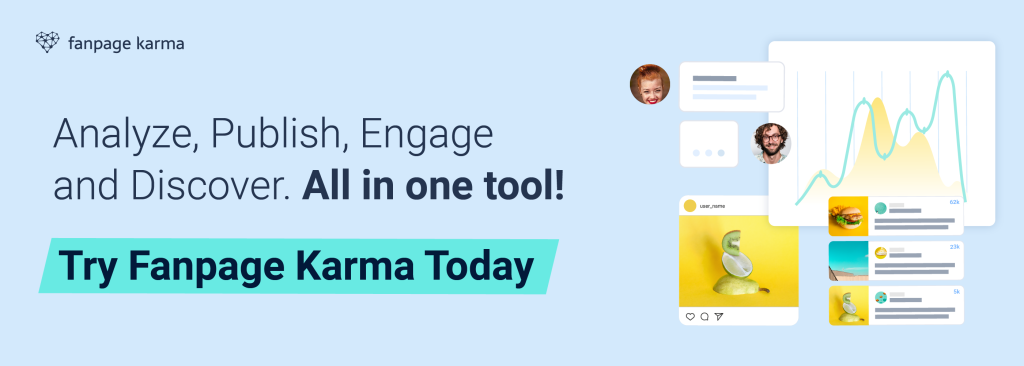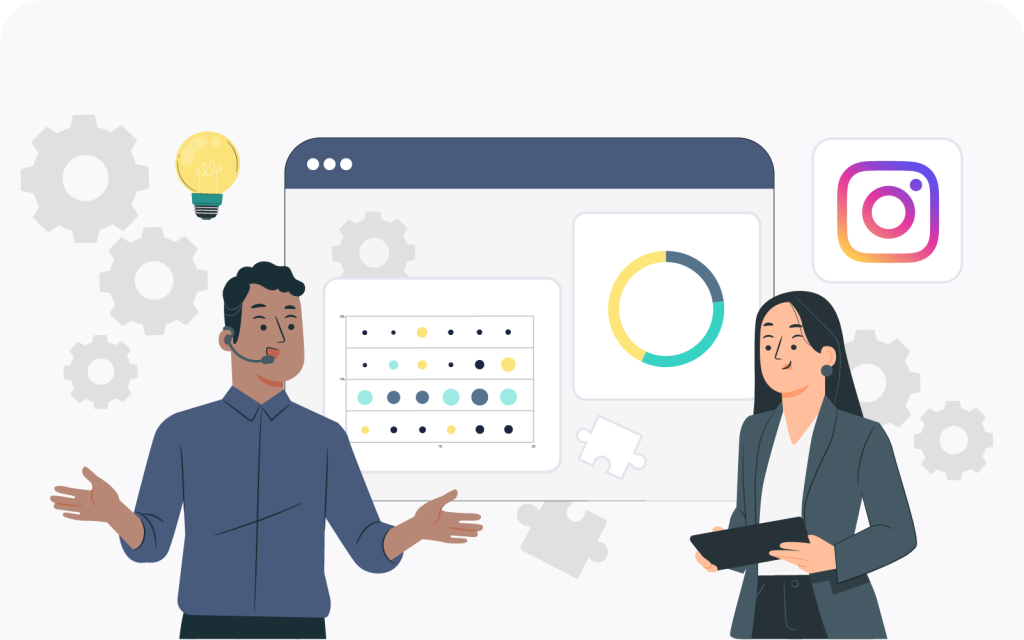The Best AI Prompts for Your Content Planning – The way to becoming a prompt pro
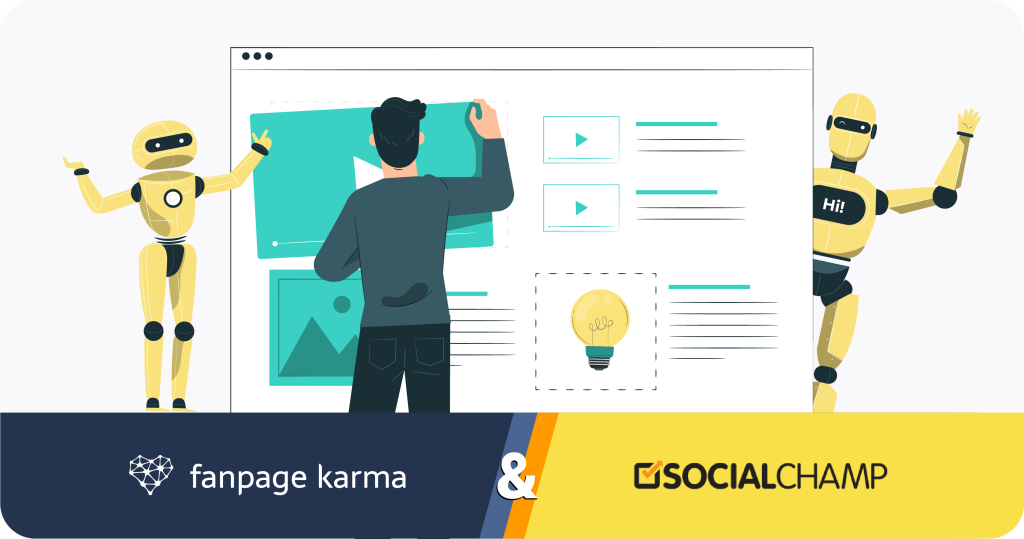
We all know about AI writing assistants like ChatGPT. By writing a prompt, i.e. an instruction to an AI model, we want to have an answer generated to a problem we pose. But the quality of the answer that the AI provides depends heavily on our prompt. This is where some of us struggle and why, after trying it once, many of us have decided, disappointedly, that AI assistants are not practical for their content creation.
The right prompts can save content creators a lot of work and time. In this new series, we explore the best prompt ideas and workflows to effectively use AI and scale our content. In part one, we learn how AI helps identify our audience and their influencers. We discover what topics they like and then have a custom content calendar created. In the following articles of the series, we show the best prompts for different content formats. The series ends with contacting influencers who can promote our posts online.
A note on choosing an AI assistant for content creators
For content creators, we recommend using an AI assistant with an internet connection so that it can research information on current trends for us. If tit doesn’t, as is the case with ChatGPT for example, then we will not get any results on current events. This is particularly disadvantageous for fast-moving social media content.
We have had good experiences with Notion AI and the HyperWrite Chat Assistant, both of which are free to try. Learn more about the best AI writing assistants here.

AI prompts for the brainstorming, research and ideation process
Who is our target audience?
Before we let our AI assistant write content for us, we should find out a bit about our target audience and the people influencing their decisions. This will ensure that the content we create will appeal to the people we want to reach.
Step 1: Define the context
The first thing we do is set a context. This context sets frameworks for how our AI helper should answer our queries. We tell our AI assistant what role it should act in and what important things it needs to know about us.
“You are a content creator of a [company and product/our service]. I want you to do some research on your typical buyers and all the influencers affecting their buying decisions. To do this, I am going to ask you some questions below.
We will then use the information you find out to develop a content marketing strategy for our company and tell stories that are in line with the values, problems and goals of our typical buyers and their influencers. The goal is for our typical buyers and their influencers to build trust in our brand through our content, and for our buyers to engage with our brand again and again in their customer journey.”

Step 2: What are the questions in the minds of our target audience?
Having set the context and defined our goal, we can now start to find out more about our typical buyers or users. We ask:
“Find out who the typical buyers/users of [our product/service] are. What are their demographic characteristics?”
We also want to identify important problems and issues our typical buyers face. Therefore, we further ask:
“What problems and what goals do the typical buyers/users of [our product/service] have? What motives do they have to buy our product / use the service? What values must a company and a product represent or fulfil so that our typical buyer likes to buy them. What factors influence their buying decisions when they choose [a product in our product category]?
Describe the main steps that such a typical customer goes through in his/her customer journey, from the first point of contact to the moment he/she becomes a loyal customer. For each step, consider the typical buyer’s emotions, questions, goals and difficulties that weigh on him/her emotionally.”
We also ask:
“What are the biggest obstacles and doubts that a typical buyer feels when it comes to making a purchase decision for [our product/service]? What questions preoccupy our typical buyers and what emotional and rational factors play an important role for them?”
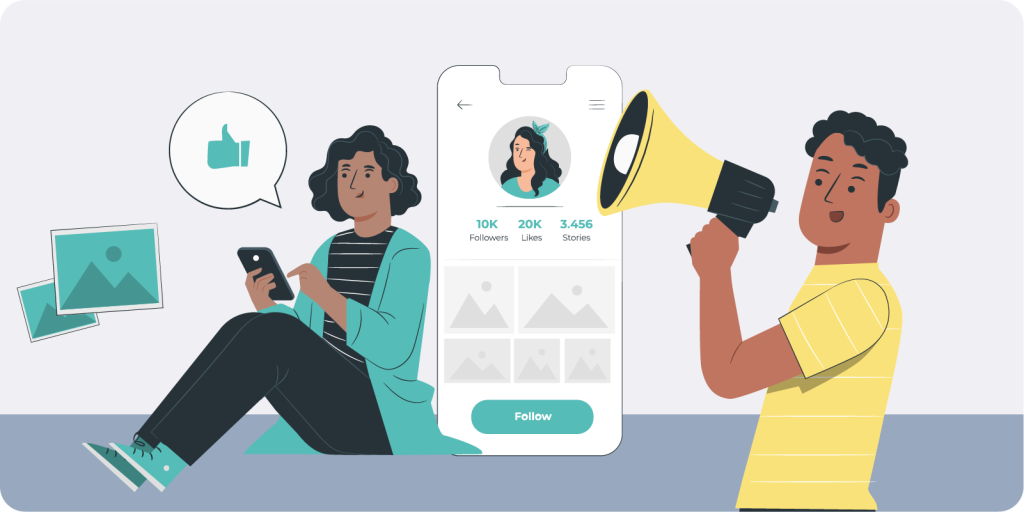
Step 3: Which people influence the purchase decision of our target group?
In addition, it is important to know which other people and events play an important role in the purchase decision of our target group:
“Describe 2 typical people in our buyer’s circle of friends, and name 5 influencers whose posts he/she consumes, as well as 2 well-known industry events that have an impact on our typical buyer’s purchase decision.”
Step 4: Which marketing channels and post formats are best to reach our target audience?
Next, we ask which online platforms and which post formats our target audience, and the people who influence their decision, consume:
“Tell me the main digital channels and social media platforms that our typical buyers, people in their circle of acquaintances and influencers use to find out about [our niche], to find answers to their questions and problems, and to get new ideas. Is it Instagram, Facebook, Twitter, TikTok, YouTube, LinkedIn, product comparison sites, blogs, forums? Describe the role each of these channels plays in the customer journey.
Also tell me what types of posts are popular with these influencers and what types of posts you would use to reach these customers. Types of posts could include short videos, carousel posts, and photos. Types of posts could include: functional product demonstrations, product explainer videos and how-tos, extreme product demonstrations, showing the product at events popular with the target audience, fun or exciting industry-related posts, fun non-product-related posts, interviews with well-known people in the industry.”

Step 5: What style of language will convince our target audience the most?
Now we already have a lot of important information that we can use for our content planning.
To be even more responsive to our target audience, we next want to find out which language style and persuasive approach is best when writing content for our target audience. First, we tell the AI what we mean by a persuasive approach. Then we let it tell us what is best for our target audience:
“Persuasion approaches are linguistic techniques that pursue the goal of influencing people’s behavior. To achieve this goal, they follow a clear structure and consist of a chain of arguments that uses emotional and rational arguments. Persuasion approaches are formulated in such a way that the person to be persuaded understands the rationale. They use words and comparisons that the audience itself uses in its everyday communication.
Which writing style and persuasion approach are best suited to persuade our typical customer to [we describe the goal, e.g. buy a product; … keep coming back to a web page and engage with our social media posts; etc.]? Consider, among other things, whether factual or emotive language is more appropriate, whether rational or emotional arguments are more effective, and whether product-focused content, such as that published by Samsung, or entertainment-based content, like that produced by Red Bull, is better suited to reaching this goal.
Describe the writing style and persuasion approach so clearly that when I later tell you to use this style in a post such as a tweet or social media ad, you understand perfectly clearly how the tweet or ad needs to be structured and worded.”

Step 6: Create a fact sheet about our target group
Finally, we want to capture the most important information about the people whom we are producing our content for in a single document. The target group fact sheet we now create defines our typical buyers in a few sentences and summarizes important information that will help the AI assistant in finding the right content ideas.
For ourselves, such a fact sheet helps us to create target group-specific posts. For the AI assistant, it defines important conditions for the upcoming idea generation phase.
“You’ve given me a lot of information about my typical buyers: about their goals and problems, their customer journey and the digital touchpoints they use when looking for a solution to their problems and desires regarding [our product], about the emotional and functional requirements they have for [our niche] product, about the post types and post forms that are most suitable, and about the public and private influencers in their lives who are most likely to influence the purchase decision for our product, and much more. You have also defined the writing style and designed a persuasive approach that is best suited to appeal to and convince the typical buyer.
From all the information you have given me, create a comprehensive fact sheet that describes our typical buyers. This fact sheet will be used from now on in our conversations when we create social media posts, email newsletters, blog articles or anything else for these buyers. Write this fact sheet so that when I refer to it, you have absolutely all the information you need to create posts that [target, e.g. will create awareness with this audience; … we can use to build high visibility in Google searches in the long term; etc.]. If there’s anything else you need to know about the target audience in order to create posts that achieve this goal, I want you to find out that information and add it to the fact sheet.”
Save the target group fact sheet you have created. We will need it for subsequent prompts.
Discover exciting topics that appeal to your target group
Now that we have a better description of our target audience and a summary with the most important information, we can move on to the next step of content planning: finding topics. The goal of this section is to identify content topics that are relevant to our target audience for the platforms they spend time on.
We start this section by scouting out the most popular topics, as well as the biggest trends and events in our industry. Afterward, we integrate the information about our target group that we gathered earlier and ask our AI helper to come up with more problems, questions, goals and wishes that our specific target audience has and that we can create content about.
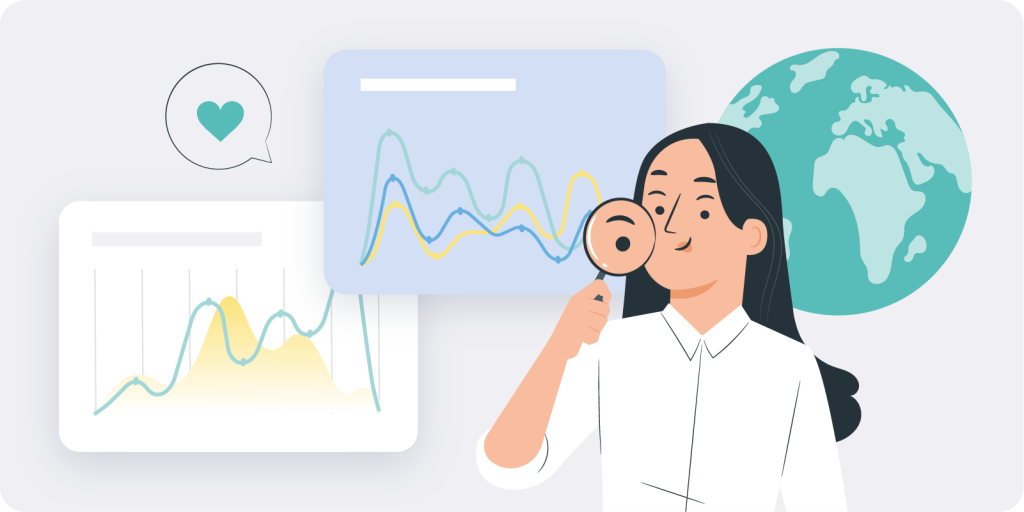
Identify industry trends
The following prompts help us identify the biggest trends, events, and content styles in our industry. Those have the highest chance of triggering the social media algorithms.
If, while analyzing these trends, we notice that we ourselves could potentially make a valuable contribution to one of the topics, then we can take advantage of the already existing clout and produce content on that topic ourselves. We ask our AI assistant:
“Give me a summary of the top 10 most discussed [type of discussion, e.g. topics, people, events, issues, controversies, trends, questions] in [our niche], based on [metric or post form, e.g. general discussion and debate].”
Example: “Give me a roundup of the top 10 most talked about controversies in healthcare. Sort the results by the number of Instagram posts posted on this topic in the last three months.”
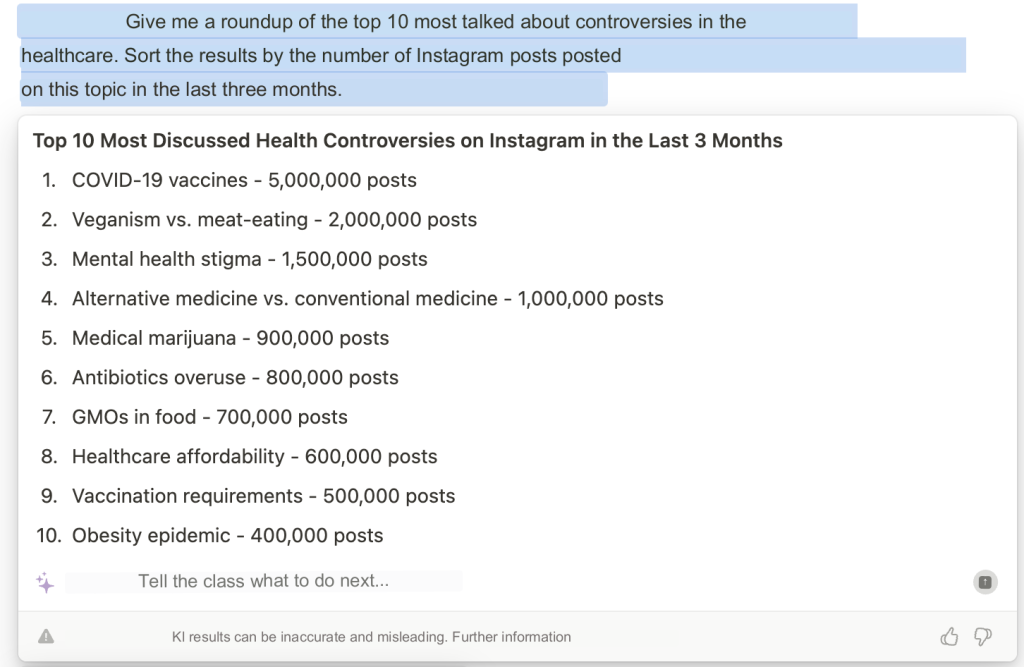
Other questions we can ask our assistant are:
“What types of posts on [platform, e.g. TikTok] receive disproportionately high engagement rates [in our niche]? Give me a top 10 list.”
and
“Create a list of 5 helpful [tools, websites, social media sites, etc.] for [our industry] professionals on [topic area], along with a use case for each and a list of pros and cons of each [tool, website, social media site].”
If we notice that we can contribute to one or more of these topics, then we note down the topic and keep it in mind for our content plan.
Target group specific topics
Start with the target group
In order to create content that specifically addresses our target audience, we should not only identify the most popular trends in our industry, but also address topics on which there may not yet be plenty of content, but which address the questions, desires and goals of our target audience.
To do this, we now use the target group fact sheet we created in the previous section. We insert it at the beginning of our next prompt:
“The following text describes a typical customer for [our product/service]:
[We insert the target group fact sheet]”
Now we ask our AI wizard for suitable topics for our target group.
Find target group specific topics
After we have inserted the target group fact sheet, we can start asking about problems and goals of our specific target group, thus discovering possible topics for our content that our customers are concerned about. Here’s what we can tell our AI helper to do:
“Summarize the news about [topic or industry] that this typical customer is most likely to be interested in.”

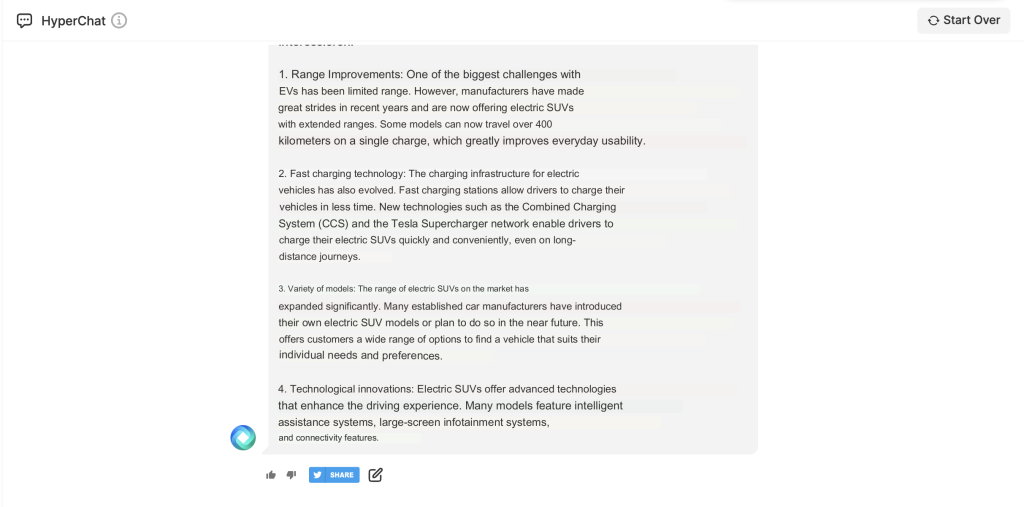
“Create a list of 3 [style that fits our target audience (see target group fact sheet), e.g. scary, funny, etc]. statistics and trends on [our topic] that might interest these customers and [target, e.g. influence his/her decision to buy our product; etc.]. Provide source links.”
“Based on what you know about our typical customer, give me three specific examples of stumbling blocks and doubts that might prevent him from buying our product, and develop suggestions on how to address and overcome each of them in an effective way. Address both rational and emotional stumbling blocks. All three examples should then be addressable in a [content format, e.g. LinkedIn carousel post].”
“Create a list of fun facts from the [our industry, e.g. electric car] industry. Tell me how to best present these facts and where to best post them on the internet, so our typical customer will hear about them.”

You can also generate meaningful captions for your social media posts using tools such as Social Champ’s exclusive Champ AI Suite.
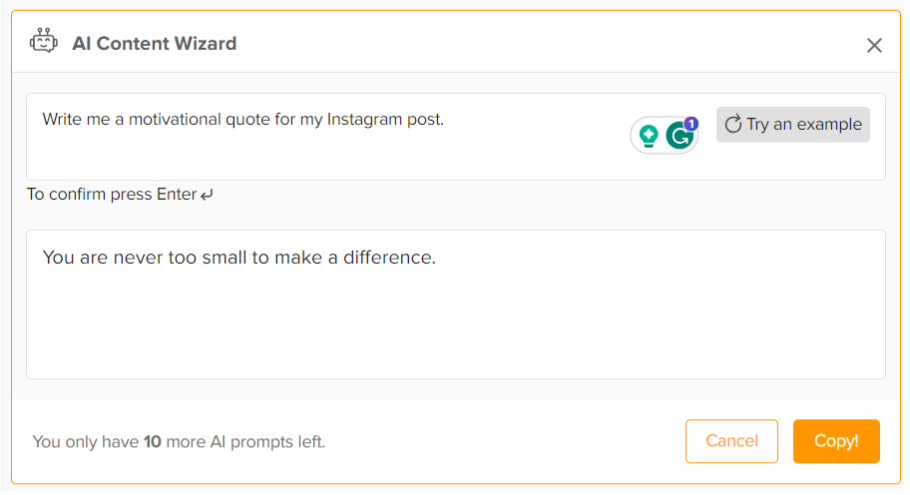
If you don’t like the topic suggestions provided to you by the AI after your first prompt, try out more than one of these prompts. By the end of this section, you should have a good idea of the types of topics and platforms you can address with your content.
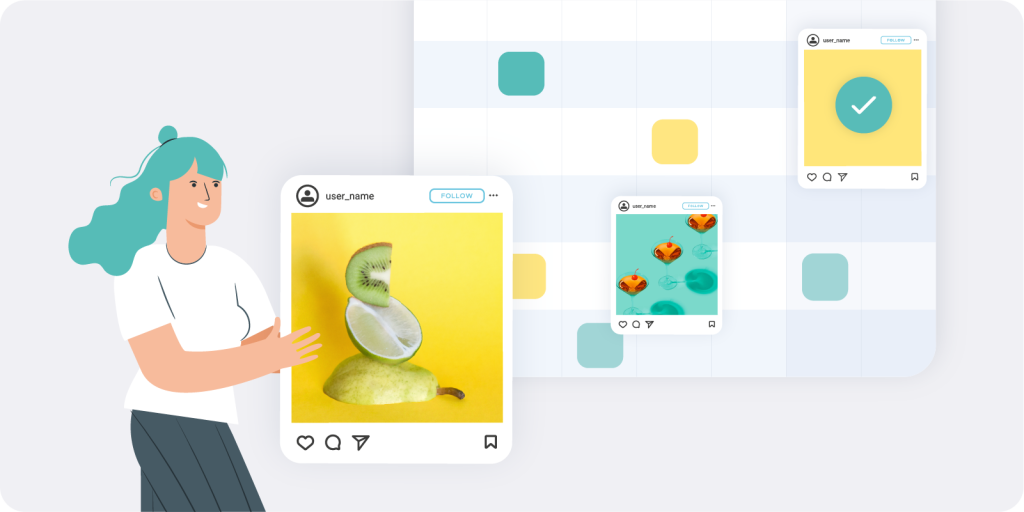
Create a content calendar tailored to you
Now that we have some topic ideas, we ask our AI wizard to create a personalised content calendar for us. To get the best possible results, we should specify any requests regarding the content types we want to produce, the timeframe, the size of our team and the skills of the team members who will be creating the posts as well as our target audience. With the following prompts, we can have our AI assistant create a personalized content calendar for us:
“You are a content planner for a [we specify the context of our company]. In your team there are [number of people] team members who produce the content. [number] of them are [role 1], [number] of them are [role 2] and [number] of them are [role 3]. The content must be produced exclusively by these team members and should cover the following topics:
[We now include the list of topics we liked from those just suggested].
The content calendar should target the following audience:
[We insert the target group fact sheet].
The content calendar should be based on three types of posts popular with the target audience [Alternatively, you can decide on the pillars of your content strategy yourself here, e.g. The content calendar should be based on blog posts, 15-, 30- and 60-second social media videos, 5-7 minute YouTube videos and email newsletters].
Create a content calendar for [time period, e.g. next month/quarter/year] that takes all these factors into account. The goal is to [our goal, e.g. increase awareness among this target audience; … build high visibility in Google searches in the long term; etc.]. Present the calendar in spreadsheet format.”
With this prompt, the AI will create a content calendar for us that should match our target audience’s interests and questions 100%.
Conclusion
AI tools can save a lot of time and work when it comes to marketing and especially during content planning. But the quality of the AI’s suggestions depends on the prompts we craft.
With the prompts we talked about in this article, we can improve our content planning, scale it and still keep our own fingerprint.
In the next articles of this series, we will learn how to use our AI helper to help us create complete content pieces around the topics we discovered, thus saving us more work and time.
